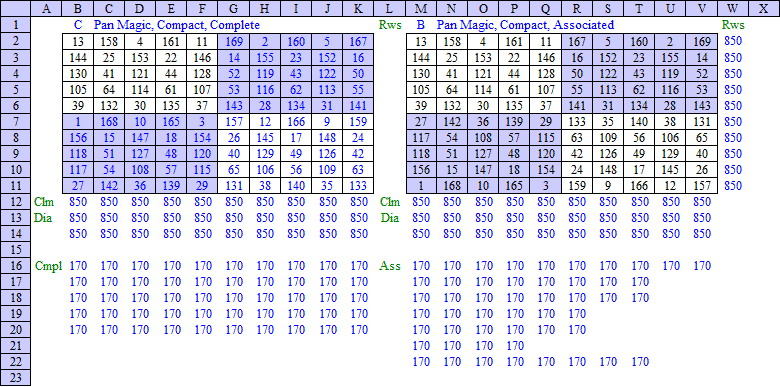Office Applications and Entertainment, Magic Squares | ||
|
|
Index | About the Author |
|
10.5 Construction Methods, Non Consecutive Integers
Although, as mentioned in Section 6.1 Pan Magic Squares of order (4n + 2) - based on consecutive distinct integers - don't exist it is possible to construct individual Pan Magic Squares of order 10, with non consecutive integers.
10.5.2 Associated, Compact, Pan Magic
Associated Compact Pan Magic Squares of order 10 can be constructed by means of following method:
As an example, subject method has been applied in an Excel spreadsheet for s1 = 60 and n = 0, which results in an Associated Compact Pan Magic Square of order 10 with Magic Sum MC = 850, as shown below: |
|
Based on the resulting variable values {bi}, numerous Associated Compact Pan Magic Squares can be generated with routine MgcSqr10e.
10.5.3 Compact, Pan Magic, Complete
A Compact Complete Pan Magic Square C can be constructed based on an Associated Compact Magic Square B as constructed above by applying following transformation (Euler):
As an example, subject method has been applied in an Excel spreadsheet on the Associated Compact Pan Magic Square B constructed in Section 10.5.2, as shown below: |
|
It is also possible to generate numerous Most Perfect Pan Magic Squares based on the obtained variable values {bi}
directly with routine MgcSqr10d.
10.5.4 Miscellaneous Magic Sums
The equations defining 2 x 5 Magic Rectangles for which the 10 elements sum to s1 are: a(6) = s1/2 - a(7) - a(8) - a(9) - a(10) a(5) = s1/5 - a(10) a(4) = s1/5 - a(9) a(3) = s1/5 - a(8) a(2) = s1/5 - a(7) a(1) = s1/5 - a(6)
with a(7), a(8), a(9) and a(10) the independent variables. Consequently the sum of the variables s1 should be divisible by 2 * 5 = 10.
|
|
|
Index | About the Author |

